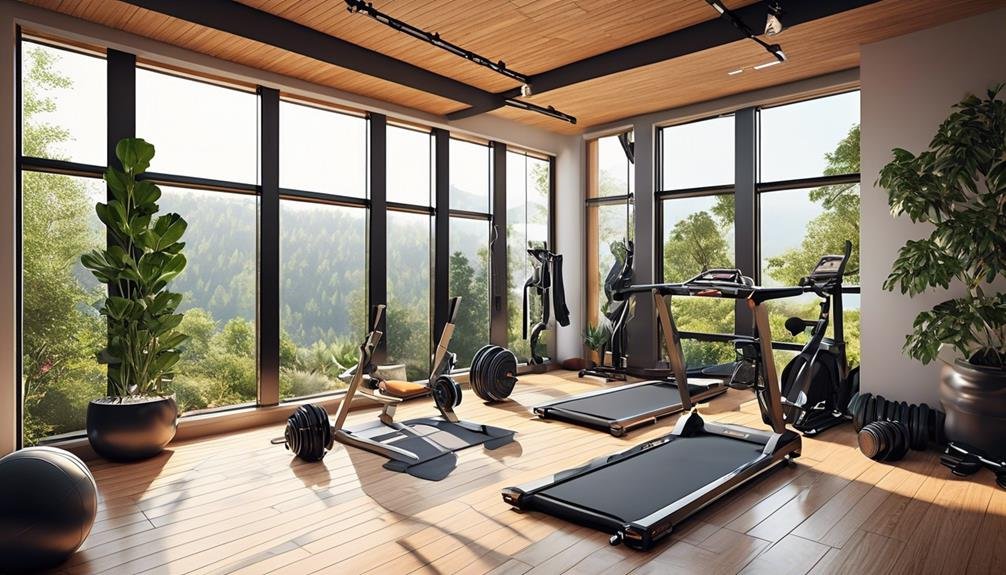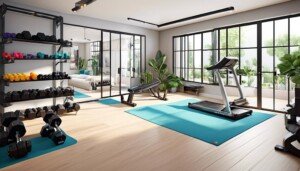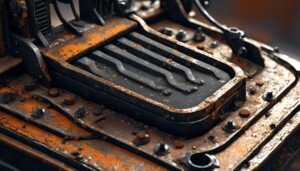Have you ever found yourself wondering where to place mirrors in your home gym to ensure proper form checks? Well, fret no more, because in this discussion we will explore the best mirror placements for optimal visibility and form monitoring.
By strategically positioning mirrors in key areas of your home gym, you can effectively assess your form and make necessary adjustments. Whether you are lifting weights, performing cardio exercises, or practicing yoga and Pilates, the right mirror placement can be a game-changer.
So, let's dive in and uncover the secrets to mirror placement that will enhance your workout experience and help you achieve your fitness goals.
Key Takeaways
- Install three strategically placed mirrors throughout the home gym for full body visibility during exercises.
- Position mirrors in front of the squat rack and beside it to check form from different angles.
- Mount mirrors at a height that matches your own for optimal coverage and visibility.
- Opt for larger mirror sizes, such as 36 x 60 or 24 x 48, depending on the available space in the gym.
Positioning Mirrors for Full Body Visibility
To achieve full body visibility in your home gym, it's recommended to install three mirrors strategically placed throughout the space. These gym mirrors will allow you to monitor your form and ensure proper technique during your workouts.
The first mirror should be positioned in front of the squat rack, providing a clear view of your entire body as you perform squats and other lower body exercises.
The second mirror should be placed beside the squat rack, allowing you to check your form from different angles.
Lastly, a mirror should be placed in front of the open training space, giving you a comprehensive view of your entire body during various exercises.
When choosing the type of mirror for your home gym, opt for a 36 x 60 mirror as the best size for full body visibility. If space is a constraint, a 24 x 48 mirror can be a suitable alternative. It's important to purchase gym mirrors from reputable sellers specializing in fitness equipment to ensure quality and durability.
To mount the mirrors, secure them to the wall at a height that matches your own, with the top edge at least equal to your height. This allows you to see your full body reflection without any obstructions. Make sure to ensure stability and proper installation to prevent accidents or damage.
Placing Mirrors Near Weightlifting Stations
Consider placing mirrors near weightlifting stations to enhance your form and ensure proper technique during your weightlifting exercises. Mirrors positioned in front of and beside the squat rack and in front of the open training space can provide you with a clear view of your movements and help you identify any form errors.
When mounting the mirrors, make sure that the top edge matches your height at a minimum to ensure full visibility. The recommended size for the mirrors is 36 x 60, but if space is limited, a second-best option would be 24 x 48.
Additionally, consider the natural lighting in your gym and the proximity of the mirrors to the workout areas. Placing the mirrors on the wall opposite the weightlifting stations will allow you to easily observe your form while performing exercises like squats, deadlifts, and overhead presses.
Installing mirrors near your weightlifting stations is a simple DIY project that can greatly improve your fitness experience at home.
Installing Mirrors Alongside Cardio Equipment
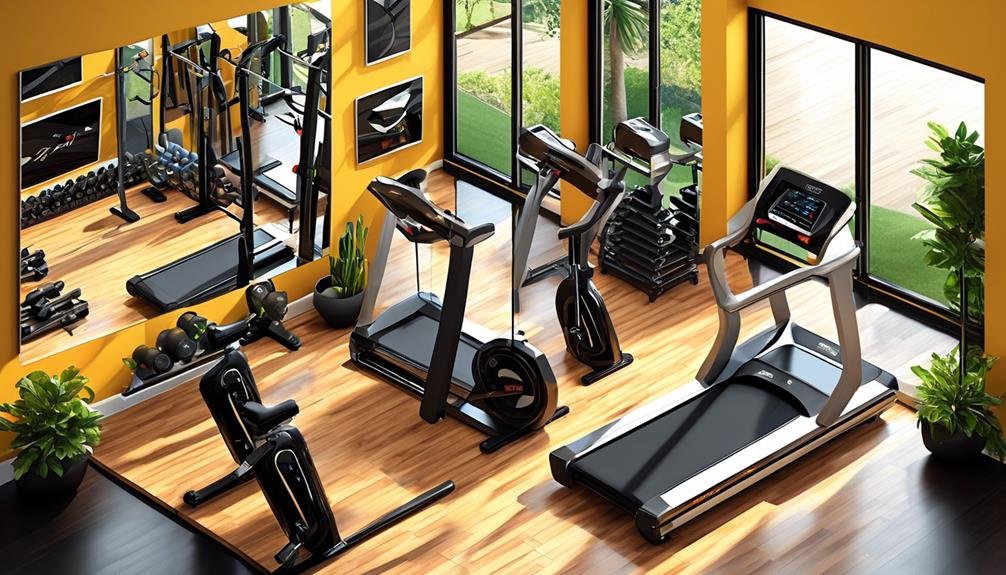
When installing mirrors alongside cardio equipment in your small home gym, strategically position them to provide a clear view of your movements and ensure proper form during your cardio workouts. By placing a mirror in front of your treadmill, elliptical, or stationary bike, you can easily monitor and correct your form as you exercise.
Consider mounting the mirror on the wall opposite the cardio equipment, at a height where the top edge matches your own height at a minimum. This will allow you to see your entire body while you perform your cardio exercises, helping you check your form and make necessary adjustments.
For the best fit in a home gym, opt for a mirror size of 36 x 60 or 24 x 48. These sizes provide sufficient coverage without overpowering the space. It's recommended to purchase fitness mirrors from specialty fitness equipment stores or glass companies to ensure quality and durability.
Using Mirrors to Monitor Yoga and Pilates Form
As you shift your focus to monitoring your form during yoga and Pilates exercises, strategically place mirrors in front of the open training space to ensure clear visibility of your full body and maintain proper alignment.
By having mirrors in your gym, you can easily look at yourself and see if you're performing the movements correctly. This visual feedback is important because it allows you to make real-time adjustments and avoid any potential injuries.
When positioning the mirrors, make sure to mount them at a height where the top edge matches your own height. This will ensure that you can see your entire body during the workouts. Additionally, consider installing mirrors beside equipment like a squat rack to check your form during weighted exercises and ensure proper alignment.
If you have a larger space, mirrors sized 36 x 60 can provide comprehensive visibility, while 24 x 48 mirrors can be effective for smaller areas. You can purchase mirrors from home improvement stores or glass companies and make sure to securely mount them to the wall for reliable form checks.
With the help of mirrors, you can visually monitor your form, maintain proper alignment, and feel confident in your yoga and Pilates practice.
Strategic Mirror Placement for Functional Training Areas
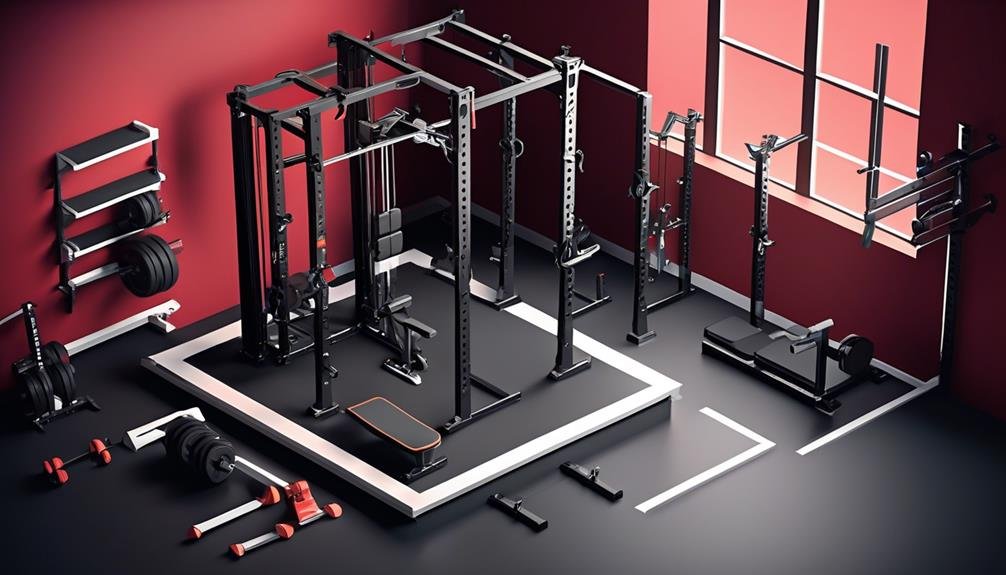
To ensure comprehensive form checks and proper visibility, strategically place mirrors in functional training areas such as in front of the squat rack, beside the squat rack, and in front of the open training space.
Here are some key points to consider when placing mirrors in these areas:
- Mount the mirrors at a height that matches your own, ensuring that the top edge is at least at your eye level. This will allow you to assess your form accurately.
- Opt for larger mirrors that provide better coverage and visibility. Mirrors sized 36 x 60 are ideal, but if you have limited wall space, 24 x 48 mirrors can be a suitable alternative.
- Purchase mirrors from reliable suppliers who specialize in gym equipment or check out home improvement stores for suitable options.
- Install the mirrors flat against the wall, perpendicular to a window if possible. This will maximize natural lighting and help you see your movements clearly.
- Ensure that the mirrors are placed away from potential hazards, such as heavy equipment or sharp edges, to prevent accidents.
Mirror Placement for Proper Squat and Deadlift Form Checks
Place mirrors strategically in front of the squat rack and beside it to ensure proper form checks and visibility from different angles. When it comes to squatting and deadlifting, having a clear view of your form is crucial for maximizing results and preventing injuries.
To achieve this, mount large mirrors that are at least 36 x 60 inches in size. This will provide optimal visibility during your workout routine. If you have limited space, consider a secondary mirror option of 24 x 48 inches.
When mounting the mirrors, ensure that the top edge matches your height. This will allow you to see your entire body during the exercises. You can find gym mirrors at home improvement stores or specialty fitness equipment retailers.
Mirrors for Monitoring Upper Body Exercises
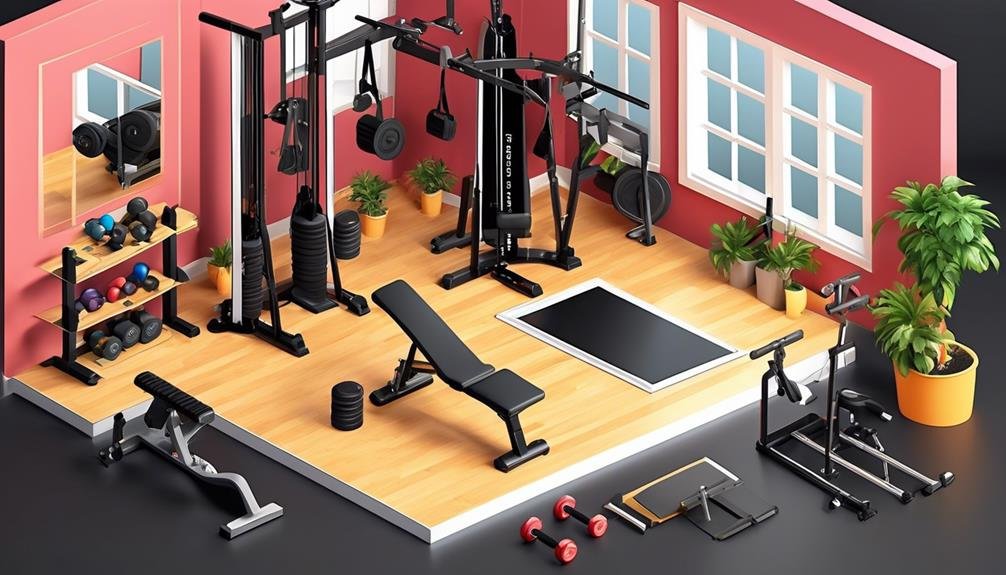
For effective monitoring of upper body exercises, strategically position mirrors in your home gym. Mirrors play a crucial role in ensuring proper form checks during your workout routine.
Here are some important considerations when it comes to using mirrors for monitoring upper body exercises:
- Place one mirror in front of the squat rack and another beside the squat rack. This setup allows you to observe your upper body movements from different angles, helping you make necessary adjustments to your technique.
- Mount the mirrors at a height where the top edge matches your height at a minimum. This ensures optimal visibility during form checks, allowing you to see your entire upper body, including your arms, shoulders, and back.
- Consider the size of the mirrors. Ideally, 36 x 60 is the best size for upper body exercise monitoring. If space is a constraint, a 24 x 48 mirror can also be a good option. These sizes provide sufficient coverage for you to assess your form accurately.
To ensure quality, purchase gym mirrors from relevant suppliers or retailers specializing in fitness equipment and accessories. Additionally, follow proper mounting techniques to securely install the mirrors for effective form checks during your upper body exercises.
Whether you have a commercial gym or a garage gym, having the right mirrors in place can greatly enhance your workout experience and help you achieve your fitness goals.
Considerations for Mirror Placement in Small Home Gyms
If you have a small home gym, strategically placing mirrors is essential for effective monitoring of your upper body exercises. When it comes to mirror placement in a small home gym, there are a few key considerations to keep in mind.
First, it's recommended to install 1-3 mirrors in your gym space. One mirror should be placed in front of the squat rack, allowing you to check your form during exercises like squats and lunges. Another mirror should be placed beside the squat rack, providing a side view for additional form checks. Lastly, it's beneficial to have a mirror in front of the open training space, allowing you to monitor your form during various exercises.
In terms of size, it's best to opt for a mirror that's 36 x 60 inches or 24 x 48 inches. These sizes offer ideal visibility for form checks in a small home gym. When purchasing mirrors, make sure to choose from a reliable source that offers gym-specific mirrors, ensuring quality and durability.
Additionally, it's important to follow safe and secure mounting procedures to ensure stability and longevity of the mirrors for form checks. By considering these factors, you can create an effective and functional small home gym with strategically placed mirrors that will help you monitor your form and achieve your fitness goals.
Frequently Asked Questions
Where Should I Put My Mirror in My Home Gym?
You should put your mirror in your home gym in front of the squat rack, beside the squat rack, and in front of the open training space for proper form checks.
How Far off Floor Should Gym Mirrors?
To ensure proper form checks, position gym mirrors so the top edge matches your height. Optimal sizes are 36 x 60 or 24 x 48. Purchase mirrors from reliable sources. Remember, safe and effective resistance training requires proper form.
What Is the Gym Mirror Etiquette?
To ensure proper gym mirror etiquette, use them for form checks and safety monitoring during workouts. Place mirrors strategically for a spacious and professional look. Consider purchasing mirrors designed for home gym use. Respect their purpose and function.
Where Should You Place Mirrors in Your Home?
To ensure proper form checks in your home gym, place mirrors strategically at key areas such as in front of your workout station and on the side walls. This allows you to monitor your form and make necessary adjustments.
Conclusion
In conclusion, proper mirror placement in your home gym is essential for effective form checks. By positioning mirrors strategically throughout your workout space, you can ensure full body visibility and monitor your form accurately.
Placing mirrors near weightlifting stations, alongside cardio equipment, and in functional training areas will provide you with the necessary visual feedback for proper technique.
Remember to choose reputable sources for purchasing mirrors and follow the proper mounting instructions for safety and effectiveness.


